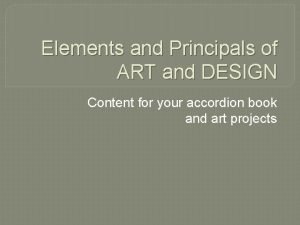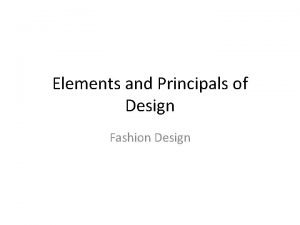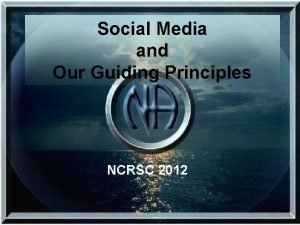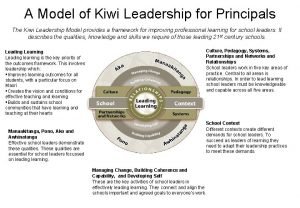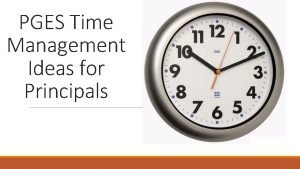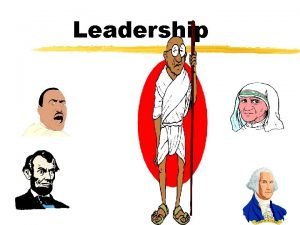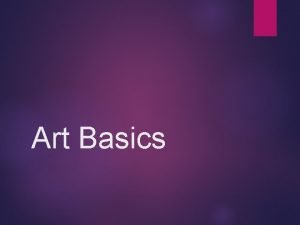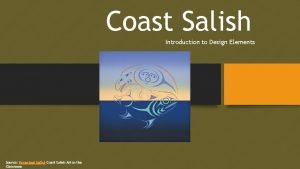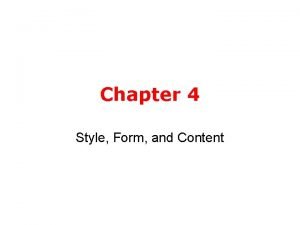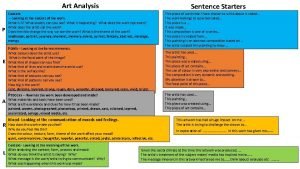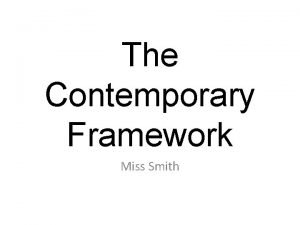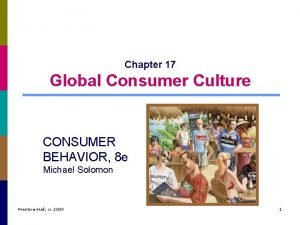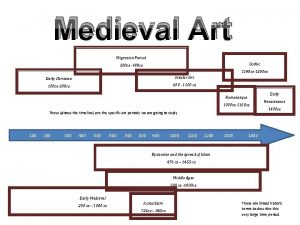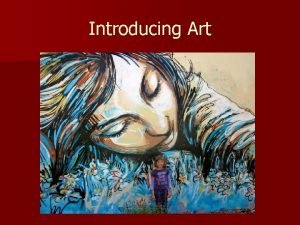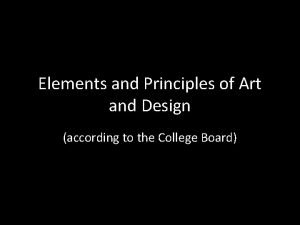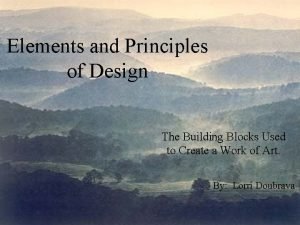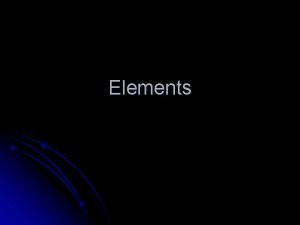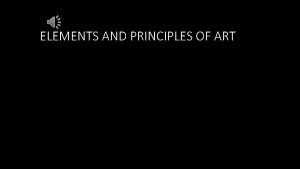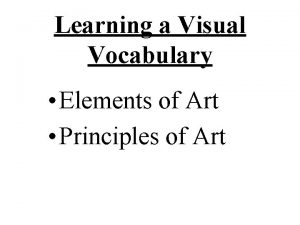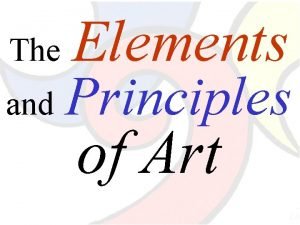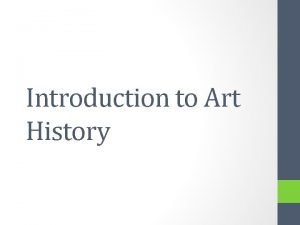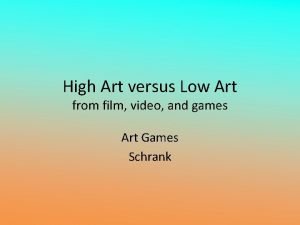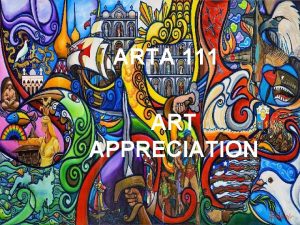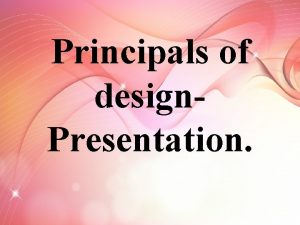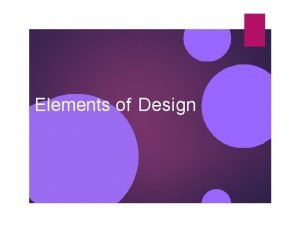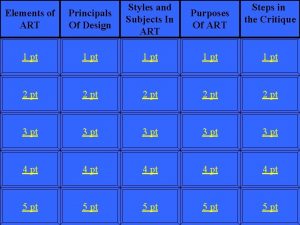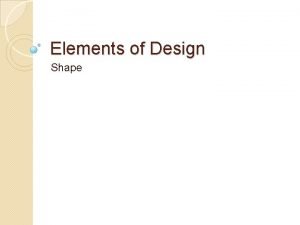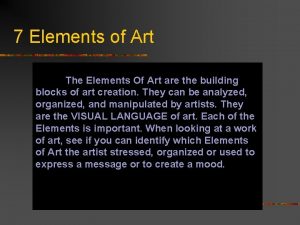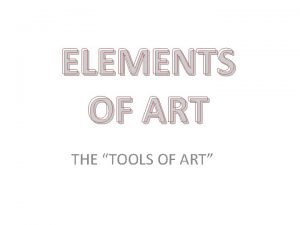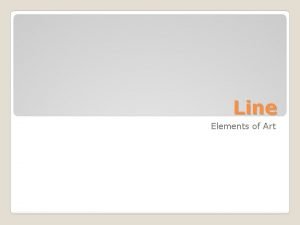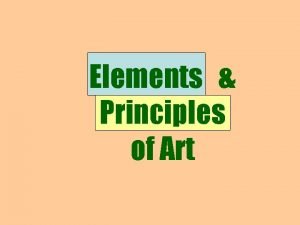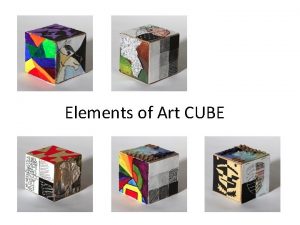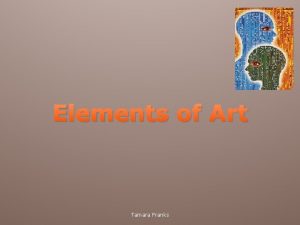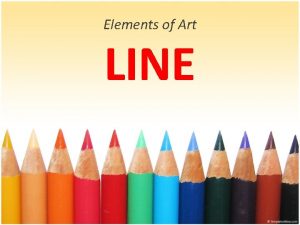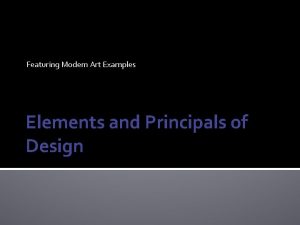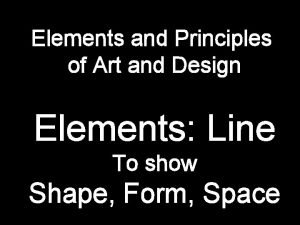Elements and Principals of ART and DESIGN Content
































- Slides: 32

Elements and Principals of ART and DESIGN Content for your accordion book and art projects

What are they? �Elements of Art • Parts that make up a piece • Structure �Line, shape, form, space, value, texture, color �Principals of Design • Concepts • They affect content and the message �Balance, emphasis, movement, pattern, rhythm, contrast and unity

Line

Line �Line: used to define shape, contours, and outlines, also to suggest mass and volume. It may be a continuous mark made on a surface with a pointed tool or implied by the edges of shapes and form • Characteristics: Width, length, direction, focus, feeling • Types: Outline, Contour, Gesture, Sketch, Calligraphic, Implied

Shape

Shape �Shape: When a line crosses itself or intersects with other lines to enclose a space it creates a shape. Shape is two-dimensional it has heights and width but no depth. � Types of Shape: Geometric, Organic, Positive, Negative,

Space

Space �Space: Space is the three-dimensionality of a sculpture. With a � sculpture or architecture you can walk around them, look above them, and enter them, this refers to the space of the sculpture or architecture. A three-dimensional object will have height, width, and depth Types of Space: Positive, Negative, Perspective, Position placing, and overlapping

Form

Form �Form: is the three-dimensionality of an object. Shape is only two -dimensional; form is three-dimensional. You can hold a form; walk around a form and in some cases walk inside a form. In drawing or painting using value can imply form. Shading a circle in a certain manner can turn it into a sphere.

Texture

Texture �Texture: Texture is the surface quality of an object. A rock may be rough and jagged. A piece of silk may be soft and smooth and your desk may feel hard and smooth. Texture also refers to the way a picture is made to look rough or smooth. � Implied vs. Real

Value

Value � Value is the range of lightness and darkness within a picture. Value is created by a light source that shines on an object creating highlights and shadows. Value creates depth within a picture making an object look three dimensional with highlights and cast shadows, or in a landscape where it gets lighter in value as it recedes to the background giving the illusion of depth � Tints, Shades, Highlights, Shadows

Color

Color � Color comes form light; if it weren’t for light we would have no color. Light rays move in a straight path from a light source. Within this light rays are all the rays of colors in the spectrum or rainbow. Shining a light into a prism will create a rainbow of colors because it separates the color of the spectrum. When the light rays hits an object our eyes responds to the light that is bounced back and we see that color. For example a red ball reflects all the red light rays. As artist we use pigments in the form of powder or liquid paints to create color.

Color: Primary, Tertiary and Secondary

Warm Vs. Cool Colors

� Complementary Colors-are colors that are opposite each other on the color wheel. . � Analogous Colors are colors that are next to each other on the color wheel for example red, red orange, and orange are analogous colors. � Triadic is where three equally spaced colors on the color wheel are used for example, yellow, Red, Blue is a triadic harmony color scheme. � Monochromatic is where one color is used but in different values and intensity. Color Schemes

Principals of Design

Balance

Balance � Balance is the stability of a picture. Most successful compositions achieve balance either through symmetrically or asymmetrically. Balance in a three dimensional object is easy to understand; if balance isn't achieved, the object tips over. To understand balance in a two dimensional composition, we must use our imaginations to carry this three dimensional analogy forward to the flat surface.

Contrast

Contrast �Contrast means showing differences in two different sections of the design or showing somehow that the design being created is very different from other designs because of its contrast. Contrast can also be used to show emphasis in any part of the design.

Proportion

� Proportion refers to the relative size and scale of the various elements in a design. The issue is the relationship between objects, or parts, of a whole. This means that it is necessary to discuss proportion in terms of the context or standard used to determine proportions. Proportion

Emphasis

Emphasis �Emphasis: is an area that first attracts attention in a composition. This area is more important when compared to the other objects or elements in a composition. This can be by contrast of values, more colors, and placement in the format.

Rhythm and Movement

Rhythm and Movement � Directional Movement - is a visual flow through the composition. It can be the suggestion of motion in a design as you move from object to object by way of placement and position. Directional movement can be created with a value pattern. It is with the placement of dark and light areas that you can move your attention through the format. Rhythm - is a movement in which some elements recurs regularly. Like a dance it will have a flow of objects that will seem to be like the beat of music

Unity

Unity �Unity: brings together a composition with similar units. If your composition was using wavy lines and organic shapes you would stay with those types of lines and not put in just one geometric shape.
 It is the range of lightness and darkness within a picture
It is the range of lightness and darkness within a picture Principals of design
Principals of design Assessform naplan
Assessform naplan Ncrsc
Ncrsc Kiwi leadership for principals
Kiwi leadership for principals Icponline.org
Icponline.org Auckland primary principals association
Auckland primary principals association Principals of cooking
Principals of cooking Time management for principals
Time management for principals Universal principals
Universal principals South african principals association
South african principals association What is esp
What is esp Dynamic content vs static content
Dynamic content vs static content Elements of art and principles of design matrix
Elements of art and principles of design matrix Coast salish art shapes
Coast salish art shapes What type of art
What type of art Analyze sentence starters
Analyze sentence starters Principles of interior design ppt
Principles of interior design ppt Non traditional art
Non traditional art Cultural formulae
Cultural formulae Book of kells time period
Book of kells time period The actual surface feel of the simulated appearance
The actual surface feel of the simulated appearance A feeling of visual equality in shape form value color etc
A feeling of visual equality in shape form value color etc Elements and principles of art
Elements and principles of art Elements and principles of art
Elements and principles of art Principles of art movement
Principles of art movement Elements of theater
Elements of theater Art vocabulary elements and principles
Art vocabulary elements and principles What is principle of art
What is principle of art Elements and sub elements
Elements and sub elements What is drama in art appreciation
What is drama in art appreciation High art vs low art examples
High art vs low art examples Division of art that are primarily seen and occupy space
Division of art that are primarily seen and occupy space
